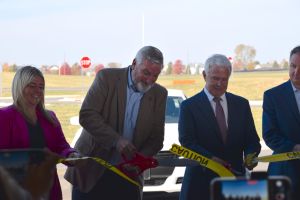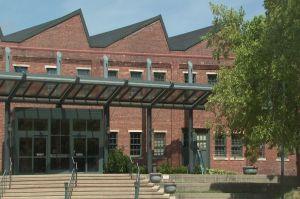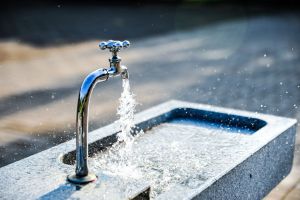
Voters line up outside of the MSD Lawrence Education & Community Center at lunchtime on Oct. 30, 2024. (Submitted by Brad Klopfenstein)
Brad Klopfenstein hasn’t voted yet, despite working in the same building as one of Indianapolis’ nine early voting centers. This year, lines at the MSD Lawrence Education & Community Center have stretched through the halls and out into the parking lot — meaning voters are waiting hours to cast their ballots.
“In years past, when I’m ready to go home, I walk downstairs, walk right in and I vote. And I have not voted yet because I don’t want to wait,” said Klopfenstein, the president of the Greater Lawrence Chamber. “I figure, at this rate, everybody in Lawrence Township will have voted by this weekend and maybe on Election Day the lines will be a little shorter.”
At lunchtime on Wednesday, voters queued up in photos Klopfenstein shared with the Indiana Capital Chronicle, which he said was “unusual” compared to prior years.
“I’ve never seen more than maybe 20 or 25 people in line. This year it’s hundreds every day,” Klopfenstein said.
Marion County is far from alone when it comes to long lines for early voters. Hoosiers in Hamilton and Allen counties have reported similar waits along with anecdotal reports of high turnout, specifically among young and first-time voters.
While it’s too early to know if this year’s turnout will eclipse previous years, Indiana traditionally has one of the worst turnout rates in the country. The 2020 general election hit a high-water mark of 65%, buoyed by an unusual election year with additional absentee voting flexibility, but sank to 40% in 2022. In 2016, another presidential year, 58% turned out to vote.
As of Oct. 24, the most recent statewide data available, more than 500,000 Hoosiers have already cast their ballots.
Kate Sweeney Bell, the Marion County clerk, said that in-person turnout locally had exceeded 2020’s numbers, with 10,560 voters showing up on Saturday, Oct. 26 — the first day all early voting locations opened up — compared to 4,430 in 2022 and 8,800 in 2020.
“I met a first-time voter who was in his 70s. He and his son, neither of them had ever voted in an election before,” Sweeney Bell said. “It gave me goosebumps.”
Calculating wait times
Enthusiasm appears to be high at a handful of sites around the state. Presidential election years typically draw more voters than other cycles.
“I think there’s a lot of interest. I cannot believe all the young people we’ve had out — we’ve had many, many, many first-time voters,” Hamilton County Election Administrator Beth Sheller said. “I know that in the presidential election you see that, but it just seems overwhelming how many young voters have been out.”
On Saturday, lines at some Hamilton County sites briefly had waits of more than two hours, Sheller said.
Machines in Hamilton County were reallocated and wait times have fallen, as verified by Indy Vote Times. Planning for early voting is easier because the county has used nearly the same nine buildings for a few election cycles, adding a third Carmel location this year, Sheller said. But the two Noblesville locations — at the county fairgrounds and judicial center — are the busiest.
Westfield City Hall, the smallest center, has the capacity for eight machines, while the other locations can fit between ten and a dozen. But flexibility isn’t really there to move around machines or poll workers to accommodate long lines.
“It is a lot of planning to make sure they have the right supplies and enough workers,” Sheller said. “It’s a constant, 12-hour or more job for several months making sure that it’s all there.”
Marion County encounters the same building size restraints, especially at the precinct locations inside of township buildings, according to Sweeney Bell.
“If there were room, we would increase the number of machines, the number of bipartisan teams, the number of check-in and check-out stations,” Sweeney Bell said. “We’re hampered by the physical locations themselves.”
Sweeney Bell described a process in Marion County to get more accurate vote times by giving voters at the end of the line tickets and timing their progress. At 3:30 p.m., she could pull up estimated wait times across the municipality, including a 98-minute wait at MSD Lawrence compared to the 21-minute wait at the City County Building downtown.
Concerns about dissuading voters
But not all officials are convinced that election preparation has been sufficient.
Derek Camp, the Allen County Democratic Party chair, has repeatedly admonished Republicans in press releases and pinned the blame for long voting lines on their actions.
He contends that county election officials are using the same number of machines for early voting as they did for last year’s much smaller municipal election.
On Saturday, the first day of early voting, lines at the downtown Rousseau Centre, the city-county building, took over two-and-a-half hours. Such waits could have been prevented, Camp said, if Republican election board members had approved an emergency meeting earlier this month to expand voting hours.
“We had been, even prior to that, seeing up to an hour, an hour-and-a-half waits just during the day. During business hours,” Camp told the Indiana Capital Chronicle. “So we did try to flag that this is going to be an issue.”
At the Rousseau Centre, “it was zigging and zagging and snaking all the way through the first floor, out the doors, across the pedestrian bridge and into the parking garage,” Camp said.
Unlike most Indiana counties, Allen County has a separate, bipartisan Election Board to handle administrative duties related to voting. To expand early voting hours, the board would need to have members from both parties approve such a move.
Allen County Clerk Christopher Nancarrow, a Republican board member, defended the group’s actions, saying the schedule had been in place for months. He also disputed Camp’s assertion and said there were fewer machines during the municipal election.
“As much as the Election Board would like to deploy all machines for early voting, you cannot use the same machines for early voting as you do for Election Day voting due to Indiana law concerning tabulation restrictions,” Nancarrow said in an emailed response.
“Any last-minute changes to the schedule without a bi-partisan agreement and sufficient staffing, especially in today’s contentious and litigious election environment, only undermine confidence in the system.”
Fifty of the county’s 715 machines were deployed, with ten at each of the five early voting locations. The strain had been alleviated by adding more poll pads, poll workers and a few additional machines, he continued.
Camp said the resources weren’t enough, frustrating voters who might decide not to cast their ballots. Additionally, he noted that Fort Wayne — the state’s second-largest population center — could factor into the tightening governor’s race.
Fort Wayne voter Emeline Hawkins, a naturalized citizen from France, said waiting is worth it for the right to vote.
“I don’t understand why people don’t vote if they have that privilege and were born here,” Hawkins said. “A lot of immigrants I know vote because we understand it’s part of the duty of becoming a citizen.”
Hawkins, a freelance journalist who has lived in the area for a decade, only had roughly a 40-minute wait at the Rousseau Centre Tuesday evening.
“A part of me is happy, because that tells me that people are voting,” Hawkins said about the long lines. “But a part of me is worried because people will see that line and then not vote.”
After hearing about long wait times on Saturday, Hawkins and her husband planned ahead and set their expectations. But not everyone has the flexibility to do that — including elderly or disabled voters who can’t stand for that length of time or parents with small children.
“There’s certain populations who can’t wait for three hours,” Hawkins observed.
Sheller said state law doesn’t allow disabled voters to jump ahead in line but that Hamilton County, at least, allows someone else to hold their spot in line. Certain voters may also qualify for an absentee ballot or a travel board for future elections to avoid lines.
“We will try to accommodate them as much as possible,” Sheller said.
Indiana Capital Chronicle is part of States Newsroom, a nonprofit news network supported by grants and a coalition of donors as a 501c(3) public charity. Indiana Capital Chronicle maintains editorial independence. Contact Editor Niki Kelly for questions: info@indianacapitalchronicle.com. Follow Indiana Capital Chronicle on Facebook and X.











